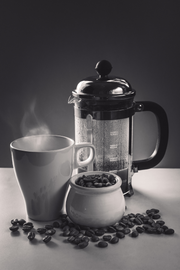Brewing Coffee 101: Understanding Different Extraction Methods for the Perfect Cup
As a coffee lover, you may have noticed that the taste of your favorite beverage can vary significantly depending on how it's brewed. This is because coffee brewing involves the extraction of flavors, aromas, and essential oils from the coffee beans, and different extraction methods yield distinct characteristics in the final cup. In this blog post, we'll explore the most common coffee extraction methods and explain them in a way that's easy to understand for entry-level coffee enthusiasts. So, let's dive in and uncover the secrets to brewing the perfect cup of coffee!
- Drip Brewing - A Classic and Convenient Choice
Drip brewing is one of the most popular and straightforward methods for brewing coffee. It involves pouring hot water over coffee grounds placed in a paper or metal filter, allowing the water to pass through the grounds and extract the flavors along the way. The resulting brew is collected in a carafe or pot below the filter.
Pros: Drip brewing is easy to set up, and machines are readily available for home use. It produces a clean cup with a balanced flavor profile, making it an excellent choice for everyday coffee.
Cons: Some coffee enthusiasts argue that drip brewing lacks the richness and complexity found in other methods, as it may not extract all the flavors from the beans.
- French Press - Full-Bodied and Immersive
The French press, also known as a press pot or plunger pot, is a simple yet effective method for brewing coffee. Ground coffee is steeped in hot water, and after a few minutes, a mesh plunger is pressed down to separate the grounds from the brew.
Pros: The French press creates a full-bodied coffee with a rich taste and more natural oils, providing a more immersive coffee experience. It's easy to use and doesn't require any disposable filters.
Cons: The French press can be a bit tricky to master as the brewing time and grind size greatly influence the final taste. If not done correctly, it may result in a bitter or over-extracted cup.
- Espresso - The Bold and Intense Shot
Espresso is a concentrated coffee brewing method that uses pressure to force hot water through finely-ground coffee beans. The result is a bold, strong, and intense shot of coffee with a layer of crema on top.
Pros: Espresso is the foundation for various coffee drinks like cappuccinos and lattes. Its intense flavors and aromatic qualities make it a favorite among coffee enthusiasts who enjoy a quick and robust caffeine fix.
Cons: Brewing espresso requires specialized equipment, such as an espresso machine. It might be a bit intimidating for beginners due to the precise grind size, tamping pressure, and extraction time needed to achieve a perfect shot.
- Pour-Over - Artisanal Coffee Brewing
Pour-over coffee brewing has gained popularity among coffee aficionados for its ability to deliver a high level of control over the brewing process. This method involves manually pouring hot water over coffee grounds in a filter, allowing for precise water flow and extraction.
Pros: Pour-over brewing allows you to fine-tune various brewing parameters, resulting in a coffee that highlights the bean's unique flavors. It's a slower process that encourages mindfulness and appreciation for the art of coffee making.
Cons: Pour-over can be time-consuming and requires some practice to master. Moreover, you'll need additional equipment, such as a pour-over dripper and a kettle with a precise spout for a consistent brew.
- Cold Brew - Smooth and Refreshing
Cold brew is an increasingly popular method, especially during hot weather. It involves steeping coarsely ground coffee in cold water for an extended period, usually 12 to 24 hours, and then filtering the liquid.
Pros: Cold brew produces a smooth, low-acid coffee concentrate that can be diluted with water or milk to your preferred strength. Its milder flavors make it an ideal base for iced coffee drinks.
Cons: The steeping time for cold brew is relatively long, which requires some planning ahead. Additionally, it may not suit those who prefer a more robust and flavorful cup of coffee.
As a coffee lover, exploring the various extraction methods can be an exciting journey to discover new flavors and enhance your appreciation for this beloved beverage. Whether you opt for the convenience of drip brewing or the artistry of pour-over, each method offers a unique experience that can cater to different tastes and preferences. So, grab your favorite beans, experiment with various brewing methods, and savor the delightful nuances of coffee in every cup!



